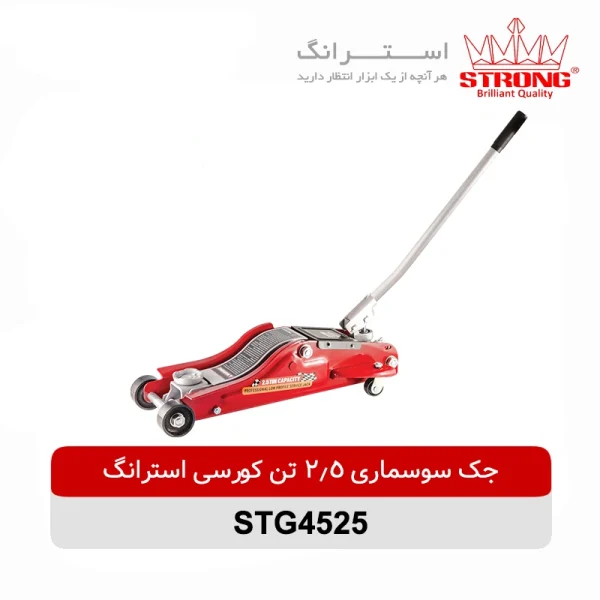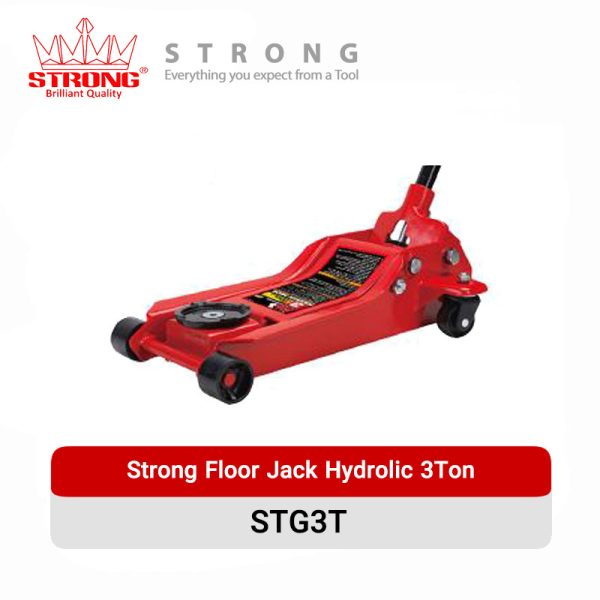Strong 2Ton Hydraulic Floor Jack + Carry Box – Model STG2T
Large wheels with the ability to rotate with resistant joints to withstand the pressures from the load and also easy to control during transport
Hydraulic safety valve to protect the device from excessive pressure
Advanced hydraulic system to improve efficiency with easy ventilation mechanism
Welding of parts using automatic machines and special tests with modern world standards
Electrostatic powder coating of body paint to prevent rust and damage to the body
Lifting performance range at a minimum height of 140 and a maximum of 350 mm
Durable and quality packaging for easy transportation
Packaging dimensions 465x220x165
What is a hydraulic jack?
A hydraulic jack is a device in which a force is applied to the oil contained in a small cylinder. This force causes the incompressible oil to be transferred to the large cylinder. The oil presses on the piston of the large cylinder, causing the load on the cylinder (for example, the machine) to lift. The working mechanism of crane machines, etc. is such that at the same time, it does a lot of useful work with high efficiency.
The construction of the hydraulic jack uses the fact that the oil is almost incompressible and transmits the applied force. The pressure on the small piston is transferred directly to the large piston and pushes it upwards.
Mechanical advantage of hydraulic jack
The pressures on the cylinders, which are the same force on the surface unit, P = F / A, are equal. Therefore:
Pe = Pl
In other words, you can write:
Fe / Ae = Fl / Al
Where F is the same as the resisting and driving forces, A is the cross section of the two pistons. In its simplest form, the mechanical advantage of the hydraulic part of the jack is as follows:
AA = Ml / Ae
The jack handle is also a second type lever and has its own mechanical advantage. The lever handle increases the driving force. A useful force is applied to the hydraulic jack and the jack increases this force. Therefore, the mechanical advantage of the whole device is equal to the mechanical advantage of these two parts.
Does the hydraulic jack increase the amount of work?
There is no device that can increase the amount of work. Each amount of oil that comes out of the small cylinder, the same amount enters the large cylinder. In both cylinders, this volume of oil is equal to the product of the cross section of the cylinder at the distance at which the piston moves. Because these volumes are equal, therefore:
AeΔSe = AlΔSl
If we consider the car without friction, we have:
MA = Al / Ae = ΔSe / ΔSl
And because MA = Fl / Fe so:
FlΔSl = FeΔSe
Which shows that ideally the output or useful work is equal to the input or given work.
In pulleys, levers and hydraulic jacks, when there is no friction, the output work is equal to the input work. The same is true of other cars. Under such conditions, the ideal mechanical advantage (ie, without friction) of any machine can be obtained by examining the geometry of the machine. By considering the equation MA = ΔSe / ΔSl, even in the most complex machine, the ideal mechanical advantage can be found only by knowing how much the resistive force is displaced when we move the driving force over a certain distance.
Applications of hydraulic jacks
In lifting heavy vehicles and machines, compressor machines, cranes, refineries, underground drilling, tower building and architecture, all vehicles, etc., this very simple and useful device or its working mechanism is used.
Types of hydraulic jacks:
There are many types of hydraulic jacks. Here are some examples
Garage or repair shop hydraulic jacks: This type of jack is one of the simplest types of jacks that are used in workshops and car repair shops, such as:
Hydraulic lizard jack – smoothing jack – oil jack or bolt jack – pallet jack – engine jack and …
Special industrial jacks: These types of jacks are designed in large and medium industries and often by special engineering design for that specific job and is produced.







Reviews
There are no reviews yet.